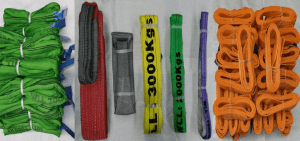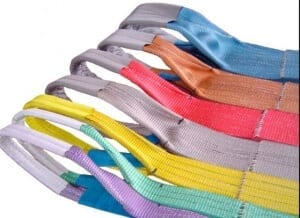Guidance on How to Use Webbing Slings Safely
29 December, 2016
Webbing slings, while possessing many similarities to our other reliable wire rope offering, differ greatly in many of the advantages that they have. Both pieces of lifting equipment are commonly utilised for similar situations, but the differences in their construction means that webbing slings come with a new set of guidance on how to use the webbing slings safely. We have laid this out more clearly for you below.
How is a webbing sling different to a wire rope?
Before we explain how to use webbing slings safely, it is worth understanding how they differ from other pieces of lifting equipment. Webbing slings are manufactured from fabric, typically polyester, making them a much more lightweight alternative to something like a wire rope. With this more lightweight and portable nature, they are much easier to transport around a worksite, and thanks to their flexibility, can be wrapped around odd-shaped objects easily. Webbing slings are also designed to not twist easily, so you don’t need to worry about getting yourself into a tangle when conducting lifting and lowering tasks!

You can see above our different range of webbing slings
How should you use webbing slings safely?
While the above information highlights the benefits that webbing slings offer to their users, it also means that they come with a different set of conditions for proper and safe use, which we have listed below.
With a more lightweight nature comes a lighter lifting capacity
Although the fact that the webbing slings are much more lightweight in nature than wire rope is a huge advantage, it also has its drawbacks too. It means that its lifting capacity is lower than that of a wire rope, and you must be careful to not over exceed these limits when using webbing slings for lifting and lowering tasks.
To make life easier for all those who have need of webbing slings, they are handily colour coded to show what the different lifting capabilities are. These colour codes are used the same no matter where you purchase your wire rope, so you can rely safely on the colours that you see. The colour codes are as follows:
- 1 tonne = Purple
- 2 tonne = Green
- 3 tonne = Yellow
- 4 tonne = Grey
- 5 tonne = Red
- 6 tonne = Brown
- 8 tonne = Blue
- 10 tonne = Orange
 Here you can see the different webbing sling colours
Be sure to double check this the lifting capacity of your webbing sling before commencing any lifting tasks; failing to do so could result in damages to the load you are lifting, your webbing sling, or yourself!
Here you can see the different webbing sling colours
Be sure to double check this the lifting capacity of your webbing sling before commencing any lifting tasks; failing to do so could result in damages to the load you are lifting, your webbing sling, or yourself!
Storing your webbing sling correctly
In line with recommendations and rules for the safe usage and storage of webbing slings, it is important that you ensure your equipment is stored in places that won’t negatively damage or compromise the quality of your webbing sling.
The recommended guidelines for storing webbing slings are as follows:
- If your webbing sling is polyester or polyamide, then you can store it in temperatures within the -40 degrees Celsius to 90 degrees’ Celsius range
- If your webbing sling is polypropylene, then you can store it in temperatures ranging within the -40 degrees Celsius to 80 degrees’ Celsius range
Alongside this, you must also consider the fact that your webbing sling is made from fabric, and will be damaged in an environment with moisture. Storing your webbing sling correctly will prolong its service life and ensure the safety of all those using it.
Inspect your webbing sling regularly and thoroughly
As your webbing sling is made of a lighter and more flexible material, it is more susceptible to damage than a wire rope might be. This isn’t to say that they are unreliable, and they are designed to maintain their quality for a long time, but it is important to bear this in mind when using them. We recommend inspecting your webbing sling before each and every use; should you notice any wear and tear then dispose of it straight away! Although it might seem a hassle to have to continuously do this, the safety of all those involved in the lifting process is the number one priority.
Want to know more about webbing slings?
If you wanted more guidance on how to use webbing slings safely, then one of our webbing sling experts would be more than happy to help.
 You can see above our different range of webbing slings
You can see above our different range of webbing slings
 Here you can see the different webbing sling colours
Be sure to double check this the lifting capacity of your webbing sling before commencing any lifting tasks; failing to do so could result in damages to the load you are lifting, your webbing sling, or yourself!
Here you can see the different webbing sling colours
Be sure to double check this the lifting capacity of your webbing sling before commencing any lifting tasks; failing to do so could result in damages to the load you are lifting, your webbing sling, or yourself!